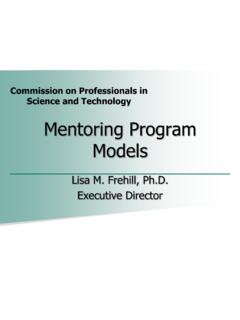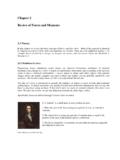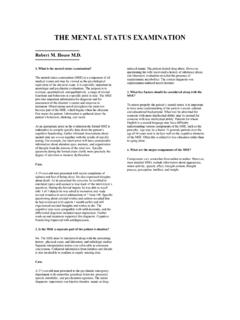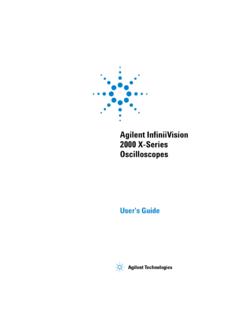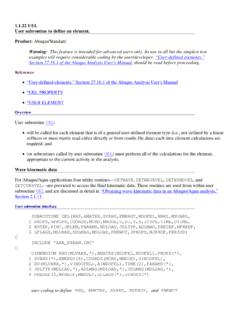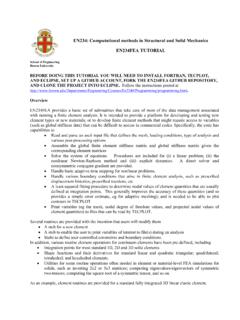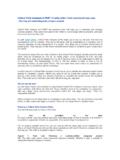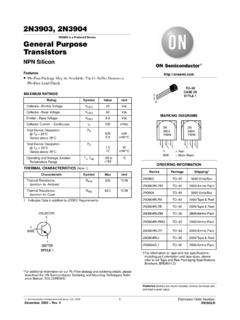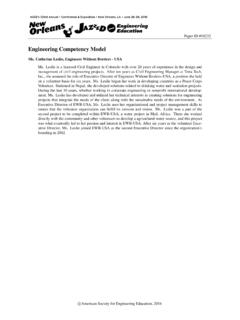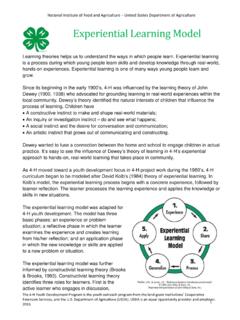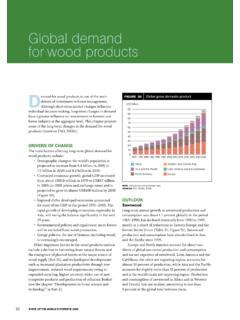Transcription of Chapter 2 The AK Model - Brown University
1 Chapter 2 The AK ModelApril 2, 20081 IntroductionThe neoclassical Model presented in the previous Chapter takes the rate of technologicalchange as being determined exogenously, by non-economic forces. There is good reason,however, to believe that technological change depends on economic decisions, because itcomes from industrial innovations made by pro t-seeking rms, and depends on the fundingof science, the accumulation of human capital and other such economic activities. Technologyis thus an endogenous variable, determined within the economic system. Growth theoriesshould take this endogeneity into account, especially since the rate of technological progressis what determines the long-run growth endogenous technology into growth theory forces us to deal with the di -cult phenomenon of increasing returns to scale.
2 More speci cally, people must be given anincentive to improve technology. But because the aggregate production functionFexhibitsconstant returns inKandLalone, Euler s theorem tells us that it will take all of the econ-omy s output to pay capital and labor their marginal products in producing nal output,leaving nothing over to pay for the resources used in improving a theory1 Euler s Theorem states that ifFis homogeneous of degree 1 inKandL(the de nition of constantreturns) thenF1(K;L)K+F2(K;L)L=F(K;L)(E)whereFiis the partial derivative with respect to theithargument. The marginal products ofKandLareF1andF2respectively. So ifKandLare paid their marginal products then the left-hand side is the totalpayment to capital (priceF1times quantityK) plus the total payment to labor, and the equation statesthat these payments add up to total verify Euler s Theorem take the equationF( K; L) = F(K;L)(C)that de nes homogeneity of degree one, and di erentiate both sides with respect to at the point = (C) must hold for all >0therefore the two derivatives must be equal, which implies (E).
3 1of endogenous technology cannot be based on the usual theory of competitive equilibrium,which requires that all factors be paid their marginal s (1962) solution to this problem was to suppose that technological progress is anunintended consequence of producing new capital goods, a phenomenon dubbed learning bydoing. Learning by doing was assumed to be purely external to the rms responsible for is, if technological progress depends on the aggregate production of capital, and rmsare all very small, then they can be assumed all to take the rate of technological progress asbeing given independently of their own production of capital goods. So each rm maximizespro t by payingKandLtheir marginal products, without o ering any additional paymentfor their contribution to technological by doing formed the basis of the rst Model of endogenous growth theory, whichis know as the AK Model .
4 The AK Model assumes that when people accumulate capital,learning by doing generates technological progress that tends to raise the marginal productof capital, thus o setting the tendency for the marginal product to diminish when technologyis unchanged. The Model results in a production function of the formY=AK;in whichthe marginal product of capital is equal to the AK Model predicts that a country s long-run growth rate will depend on economicfactors such as thrift and the e ciency of resource allocation. In subsequent chapters we willdevelop alternative models of endogenous growth that emphasize not thrift and e ciencybut creativity and innovation, which see as the main driving forces behind economic given its historical place as the rst endogenous growth Model , the AK paradigm is animportant part of any economist s toolkit.
5 Accordingly we devote this Chapter to developingthe AK Model and to summarizing the empirical debate that took place in the 1990s betweenits proponents and proponents of the neoclassical Model of Solow and The Harrod-Domar modelAn early precursor of the AK Model was the Harrod-Domar Model ,2which assumes that theaggregate production function has xed technological coe cients:Y=F(K;L) = minfAK;BLg;whereAandBare the xed coe cients. Under this technology, producing a unit of outputrequires1=Aunits of capital and1=Bunits of labor; if either input falls short of this minimumrequirement there is no way to compensate by substituting the other Harrod (1939) and Domar (1946).
6 2 With a xed-coe cient technology, there will either be surplus capital or surplus laborin the economy, depending on whether the historically given supply of capital is more or lessthan(B=A)times the exogenous supply of labor. WhenAK < BL;which is the case thatHarrod and Domar emphasize, capital is the limiting factor. Firms will produce the amountY=AK;and hire the amount(1=B)Y= (1=B)AK < Lof , with a xed saving rate, we know that the capital stock will grow according to thesame equation as in the neoclassical Model :_K=sY K:(1)These last two equations imply:_K=sAK K;so that the growth rate of capital will be:g=_K=K=sA :Because output is strictly proportional to capital,gwill also be the rate of growth of follows immediately that the growth rate of output is increasing in the saving rates:The problem with the Harrod-Domar Model is that it cannot account for the sustainedgrowth in output per person that has taken place in the world economy since the IndustrialRevolution.
7 To see this, let be the rate of population growth. Then the growth rate ofoutput per person isg . But if this is positive, then so is the growth rate of capitalper personK=L;sinceKalso grows at the rateg. Eventually a point will be reachedwhere capital is no longer the limiting factor in the production function. That is,K=Lwilleventually exceed the limitB=Aabove which labor becomes the limiting factor. From thenon we will instead haveY=BL;implying thatYwill grow at the same rate asL;that is,output per personY=Lwill cease to The Frankel Basic setupThe rst AK Model that could account for sustained growth in per-capita output was thatof Frankel (1962), who was motivated by the challenge of constructing a Model that would3combine the virtues of the Solow-Swan and Harrod-Domar models.
8 As in Solow-Swan, thismodel would display perfect competition, substitutable factors (with Cobb-Douglas produc-tion technologies) and full employment. As in Harrod-Domar, the Model would generate along-run growth rate that depends on the saving built his Model on the foundation of learning by doing. He recognized thatbecause individual rms contribute to the accumulation of technological knowledge whenthey accumulate capital,3the AK structure of the Harrod-Domar Model does not require xed coe cients. Instead, he assumed that each rmj2 f1;2;::;Nghas a productionfunction of the formyj=Ak jL1 j;wherekjandLjare the rm s own employment of capital and labor, andAis (aggregate)productivity.
9 Aggregate productivity in turn depends upon the total amount of capital thathas been accumulated by all rms, namely:A=A0 NXj=1kj! ;where is a positive exponent that re ects the extent of the knowledge externalities generatedamong simplicity assume thatLj= 1for allj;letK=NXj=1kjdenote the aggregate capital stock, and letY=NXj=1yjdenote the aggregate output all rms face the same technology and the same factor prices, they will hire factorsin the same proportions, so thatkj=K=Nfor allj:3He called it development rather than knowledge. 4 This in turn implies that in equilibriumA=A0K ;hence individual outputs are all equal toyj=A0K (K=N) and therefore aggregate output isY=NA0K (K=N) which can be written asY=AK + :(2)whereA=A0N1.
10 The Model is then closed by assuming a constant saving rate, which generates the samecapital accumulation equation (1) as in Solow-Swan and Harrod-Domar. Using the outputequation (2) to substitute forYin this equation we have_K=sAK + Kso the growth rate of the capital stock isgK=_K=K=sAK + 1 (3) Three casesWe now analyze the dynamic path of the economy de ned by equation (3). Three cases mustbe + <1In this case the extent of knowledge spillovers is not su ciently strong to counteractthe e ect1 of decreasing returns to individual capital accumulation, and thelong-run growth rate is zero. The case produces the same aggregate dynamics as theSolow-Swan Model with no technological progress and no population growth, whichwe analyzed in the previous Chapter .
